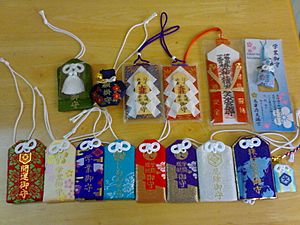Omamori facts for kids
Have you ever heard of a lucky charm? In Japan, many people use special charms called Omamori. These are like little protective amulets or talismans. People believe Omamori can keep them safe from bad luck and bring good fortune.
You can usually find Omamori sold at Shinto shrines and Buddhist temples. Each Omamori is special because it's linked to a specific Shinto god (called a Kami) or a Buddhist figure.
Long ago, Omamori were often made from paper or wood. Today, they are usually small items kept inside a pretty cloth bag, often made of brocade. Inside the bag, there might be a special prayer or a religious message. It's usually best not to open the bag, as it's believed to keep the charm's power safe inside!
What Kinds of Omamori Are There?
There are many different types of Omamori, each designed to help with a specific part of life. Here are some common ones:
- kōtsū-anzen: This Omamori helps with traffic safety. It's for drivers and people who are traveling, to keep them safe on their journeys.
- yaku-yoke: This charm is for avoiding bad things or evil. It helps to protect you from misfortune.
- kaiun: This one is all about opening up good luck and bringing better fortune into your life.
- gakugyō-jōju: This Omamori is great for students! It helps with education and passing examinations.
- shōbai-hanjō: If you want to do well in business or with money, this is the charm for you. It brings prosperity and success.
- en-musubi: This charm is for finding a special friend or partner and for marriage. It helps singles find love and helps couples keep their relationship strong.
- anzan: This Omamori is for pregnant women. It helps ensure a healthy pregnancy and an easy birth.
- kanai-anzen: This charm is for the safety and well-being of your family. It helps bring peace and good fortune to your home.
Images for kids
-
A study-dedicated omamori. The logo above denotes a Shinto shrine dedicated to the kami Tenjin






